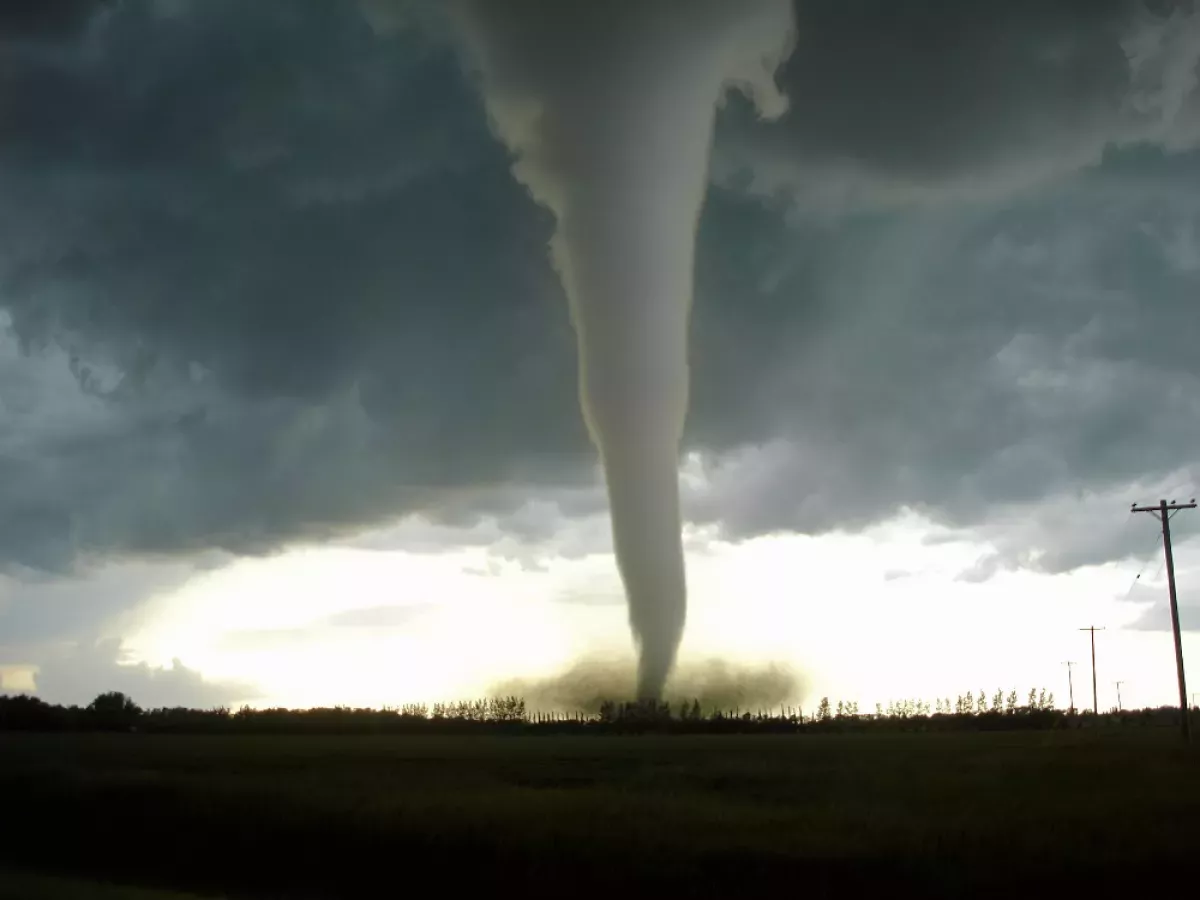A tornado is a rotating column of air connecting the Earth's surface to a cumulonimbus or cumulus cloud. Often called twisters or whirlwinds, they vary greatly in size and shape, often appearing as a condensation funnel with rotating debris. Most have wind speeds under 180 km/h, a width of about 80 meters, and travel a few kilometers. Extreme tornadoes can exceed 480 km/h, span over 3 kilometers, and travel over 100 km. The term cyclone technically refers to a low-pressure weather system with specific wind patterns, while tornado is reserved for the vortex itself.
1936: Gainesville Tornado
In 1936, the Gainesville Tornado, one of the deadliest tornadoes in history, occurred at 8:30 am local time.
1950: First Public Tornado Warnings Issued in the United States
In 1950, the first public tornado warnings were issued in the United States, marking a significant step in tornado preparedness and safety.
1952: First Tornado Watches and Convective Outlooks
In 1952, the first tornado watches and convective outlooks were established, enhancing the ability to forecast and prepare for potential tornado events.
1953: Confirmation of Hook Echoes Associated with Tornadoes
In 1953, it was confirmed that hook echoes were associated with tornadoes, enabling meteorologists to detect thunderstorms likely producing tornadoes from several miles away.
1974: 1974 Super Outbreak
In 1974, the Super Outbreak affected a large area of the central United States and extreme southern Ontario. The outbreak featured 148 tornadoes in 18 hours, many of which were violent. More than 300 people were killed.
1974: Establishment of Tornado and Storm Research Organisation (TORRO) Spotter Network
Since 1974, the Tornado and Storm Research Organisation (TORRO) has maintained a network of spotters in the United Kingdom.
April 26, 1989: Daultipur-Salturia Tornado in Bangladesh
On April 26, 1989, the Daultipur-Salturia Tornado in Bangladesh killed approximately 1,300 people, making it the deadliest tornado in world history.
1991: Andover, Kansas Tornado Outbreak
During the 1991 tornado outbreak near Andover, Kansas, a news crew and others took shelter under an overpass, inspiring the misconception that overpasses provide adequate shelter from tornadoes.
May 3, 1999: Oklahoma Tornado Outbreak
On May 3, 1999, during the Oklahoma tornado outbreak, three highway overpasses were directly struck by tornadoes, resulting in fatalities and life-threatening injuries.
June 24, 2003: Pressure Decrease Near Manchester, South Dakota
On June 24, 2003, near Manchester, South Dakota, a probe measured a 100-millibar (100 hPa; 3.0 inHg) pressure decrease near a tornado.
May 22, 2004: Hallam, Nebraska Tornado
On May 22, 2004, a tornado affected Hallam, Nebraska and was up to 2.5 miles (4.0 km) wide at the ground.
2005: Birmingham Tornado
In 2005, the Birmingham tornado registered F2 on the Fujita scale and caused significant damage and injury.
2006: London Tornado
In 2006, the London tornado registered F2 on the Fujita scale and caused significant damage and injury.
2007: Reanalysis of the Tri-State Tornado Path
In 2007, a reanalysis of the Tri-State Tornado's path suggested that the tornado may have begun 15 miles (24 km) further west than previously thought.
2007: Implementation of the Enhanced Fujita Scale in the United States
In 2007, the Enhanced Fujita (EF) scale was implemented in the United States as an update to the older Fujita scale, using engineered wind estimates and better damage descriptions.
May 31, 2013: El Reno, Oklahoma Tornado
On May 31, 2013, a tornado in El Reno, Oklahoma was approximately 2.6 miles (4.2 km) wide, making it the widest tornado on record.
Mentioned in this timeline

News encompasses information about current events disseminated through various media...
Illinois is a Midwestern U S state bordering Lake Michigan...
Oklahoma is a state in the South Central region of...

El Reno the county seat of Canadian County Oklahoma has...
Indiana nicknamed the Hoosier State is a Midwestern state in...
Bangladesh officially the People's Republic of Bangladesh is a South...
Trending

Holly Holm is an American professional boxer and former mixed martial artist She gained prominence in the Ultimate Fighting Championship...
Jordan Rodgers is an American sports commentator television personality and former football player He played quarterback signing with the Jacksonville...

6 months ago Darius Garland Out 4-5 Months After Toe Surgery: Impact on Cavs Season
Rhea Seehorn is an American actress and director most notably recognized for her role as Kim Wexler in the acclaimed...

Jared McCain is an American basketball player currently playing for the NBA's Philadelphia ers He previously played college basketball for...

7 months ago Ashton Kutcher and Mila Kunis's bathing habits spark debate; Taylor met the couple.
Popular

Candace Owens is an American conservative political commentator and author...

Tucker Carlson is an American conservative political commentator known for...

XXXTentacion born Jahseh Dwayne Ricardo Onfroy was a controversial yet...

Ilhan Omar is an American politician currently serving as the...

Kashyap Pramod Patel is an American lawyer who became the...

Bill Gates an American businessman and philanthropist revolutionized personal computing...
